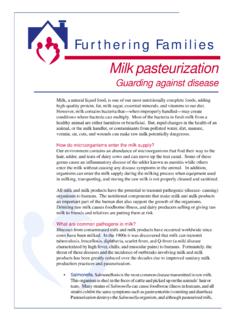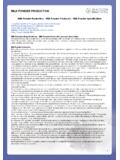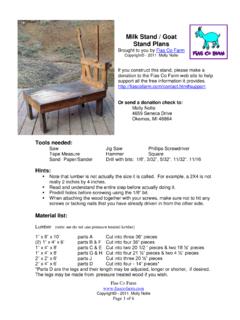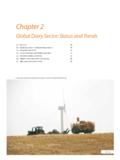Transcription of RAISING LAMBS ON MILK REPLACER - University …
1 8 RAISING LAMBS ON milk REPLACERYves M. Berger and Richard A. SchlapperSpooner Agricultural Research StationUniversity of Wisconsin-MadisonIntroductionIt is well known that the number of LAMBS born per ewe per lambing is the most importanttrait for the profitability of a sheep enterprise. Producers should approach a 200% lamb a few producers, using highly prolific breeds ( Finn, Romanov) in a crossbreedingsystem, achieve and even surpass this percentage. At the Spooner Agricultural Research Station,the level of prolificacy was quite high, reaching 300% in adult Romanov x Targhee eweslambing in March-April. This high level of prolificacy implies that single LAMBS are anexception, and triplet and quadruplet LAMBS are the rule. Although quite a few ewes are able toraise three LAMBS (some even raise four), many can raise only two. Without a doubt, severeculling of ewes with poor to fair milk production would result in an increase of the number ofewes able to raise triplet LAMBS .
2 However, selection is a slow process, and inevitably producersusing highly prolific breeds will have extra LAMBS that will have to be raised , with the new dairy sheep industry, artificial rearing of LAMBS might be a viable optionto obtain more milk (see Brett McKusick s article, page _____ ) from the people are reluctant to raise LAMBS on milk REPLACER (thus reluctant to use prolificbreeds) for several reasons: increased work load, LAMBS may do poorly, high mortality rate, and itmay not be economical. We find none of those reasons to be valid, and we would like to sharewith you the system we use to successfully raise LAMBS on milk NeededLambs should feed themselves on a free-choice basis to minimize labor and maximize theamount of milk consumed, which promotes maximum growth. We use the lamb bar systemconsisting of rubber nipples connected to the source of milk by plastic tubing.
3 The mixed milkreplacer is put in containers inside a regular cooler. The amount of material needed tosuccessfully artificially raise LAMBS will depend on the number of LAMBS the producer is planningto raise. However, the best is to keep it as simple as approximately 100 LAMBS , we use: Two or three used plastic baby bottles and used nipples in which the hole has been slightlyenlarged. It is not necessary to purchase fancy bottles and fancy nipples. One heat lamp. Three coolers (one 20 quart, two 55 quarts). One cake pan (13 x 12 x 2 ). One plastic dishpan (14 x 12 x 5 ). Two 2-gallon plastic One dozen nipples ( lamb bar). We do not use nipples with a valve system. Clear plastic tubing (outside diameter) to convey the milk for the source to the nipple. Thetube is cut to desired length. Three panels of 4 x 3 to which a sheet of tin is attached.
4 The tin is perforated with fourholes (9/16 ) to receive the nipples. Enough panels to build four pens. Cleaning equipment: brush, bottle brush, tube brushes. Several deep-freeze plastic containers to store frozen is all the material needed. As one can see, it is not much of an UsedColostrum: Cow colostrum is frozen in 16-oz. plastic containers and thawedwhen REPLACER : Only high quality lamb milk REPLACER should be used. Some people might havesome relative success with a few LAMBS using goat milk or cow milk . These milks cannot beused on a large number of LAMBS . The fat content of sheep milk is much higher than cow s orgoat s milk , and the lactose content is lower. Remember that modern lamb milk REPLACER is madeto meet the LAMBS requirements exactly. By using milk replacers according to the label, it isvery rare to see scours in young LAMBS , not even dirty rear-ends.
5 Moreover, modern lamb milkreplacers are extremely easy to mix and stay in suspension for long periods of our system, milk powder is mixed with water (one part dry powder to two parts water) byhand mixing or hand beater. Since we mix milk several times during the day, we never mixmore than four to six gallons at a Feed: A starter feed (19% CP) is provided to the LAMBS at a very early age. The starterfeed used at the Spooner Research Station has the following composition:Rolled shelled with Chloride .5%100%10 Set UpFour pens are set up: a small pen in which newborns are trained to the baby bottle, a slightlybigger pen in which LAMBS are trained to the lamb bar, an intermediate pen, and a graduate pen(Figure 1). All pens are set up in a heated area, which in the middle of winter stays at 35oF to40oF. Pens are bedded with Bottle lamb Pen: When a lamb is designated to be raised on milk REPLACER , it is placed in asmall pen (5 x 4 ) with a heat lamp in a corner.
6 In this pen, LAMBS receive an adequatesupply of colostrum (at least two feedings) and trained to eat willingly from the baby are fed approximately every four hours. This phase lasts between 24 and 48 time spent by the lamb in this pen depends on its behavior, which varies greatly betweenindividuals. Therefore, the choice of the lamb to be taken away from its mother dependsvery much on its willingness to suck on a rubber nipple. In this pen, a heat lamp is providedfor the comfort of the newborn First lamb Bar Pen: As soon as the lamb takes the bottle greedily, it is put in a slightlybigger pen (6 x 4 ) in which a lamb bar has been set up using the smaller cooler, the cakepan, two tubes, and two nipples. No more than seven or eight LAMBS are put at the same timein this pen. The cake pan is placed inside the cooler resting in a block put in the bottom ofthe cooler.
7 This keeps the level of milk high enough for LAMBS to receive the milk withoutsucking very hard. Warm milk is put in the cake pan. In wintertime, the milk is kept warmby placing a jug full of hot water in the bottom of the cooler. In this pen, LAMBS are trained tofind the milk by themselves. The first two or three feedings, LAMBS are brought to the nippleand held until the milk comes. It helps to let the LAMBS get slightly hungry before the firstfeeding. Some LAMBS understand the principle of the surrogate mother right away; others area little bit more reluctant, but all can feed themselves adequately in 48 hours. It is importantto observe the LAMBS from a distance and take note of the ones eating well by LAMBS can be put in the intermediate Intermediate Pen: This pen is much bigger (12 x 5 ), where 15 LAMBS can be put together. Afour-nipple lamb bar is set up with a bigger cooler.
8 A plastic dishpan(14 x 12 x 5 ) filled with warm milk is placed inside the cooler, again raised on ablock to keep the level of milk high enough for easier sucking. At this point, no jug of hotwater is placed in the cooler. It does not matter if the milk is allowed to cool. LAMBS areadvanced to the graduate pen when they are doing well in this Graduate Pen: A much larger pen (12 x 15 ) where up to 30 LAMBS are together. A four-nipple lamb bar is set up. The cooler is big enough to hold two 2-gallon plastic pails filledwith cold milk . LAMBS do very well on cold milk and it keeps them from eating too much atone time. In this pen, a starter feed is put at the disposition of the LAMBS . At this stage, lambsare no longer a source of intense work. It is enough to bring them fresh milk at regularintervals and watch them grow. LAMBS ARE VACCINATED WITH C, D & T ASSOON AS THEY ARE 10 DAYS Routine1.
9 In the early morning, the person in charge of the LAMBS starts the day by completelydismantling all the lamb bars and washing all elements thoroughly with detergent, brushes,11and hot water. It is our theory that since we are dealing with dairy products, cleanliness isthe most important factor in keeping the LAMBS lamb bars are set up again. Fresh milk is mixed (warm or cold, according to pen).3. Fresh bedding is put in all pens. Feed is put in pen four. Some LAMBS move from pens threeto LAMBS in pen one are fed milk in the bottles. Some of the LAMBS will move to pen LAMBS in pen two are trained at the lamb bar. Some LAMBS are moved to pen New LAMBS are put in pen one. The choice of those LAMBS is mostly based on the behavior ofthe LAMBS . Priorities are given to LAMBS that willingly drink from a bottle. However, effortsare made to keep LAMBS of the same size with the During the day, the levels of milk in the coolers are checked regularly and more milk ismixed when are weaned abruptly anywhere from 17 to 45 days with an average of LAMBS are always weaned at an older age that regular LAMBS .
10 As a rule of thumb, LAMBS areweaned when they are close to three times their birth average of days for age at weaning is fairly high, although many LAMBS wereweaned at a much younger in days % of lambs15 to 19 to 24 to 29 to 34 to 39 to 50 a rule, the smaller the lamb is at birth, the older it is at weaning. At weaning, LAMBS areremoved from the nursery area. They are put in a pen as far away as possible from sensitiveears. For the next two or three days, LAMBS will bleat ferociously and lose some of their soon the amount of feed consumed increases rapidly and a very decent growth rate isachieved. For the next few weeks, a high protein ration is first LAMBS of the season are always the most difficult to wean since no experiencedlambs are around to share their expertise. Thereafter, LAMBS that are added to the already weanedgroup, wean easier and with less of LAMBS Raised on milk ReplacerBetween 1989 and 1998, a total of 903 LAMBS were raised on milk REPLACER .







